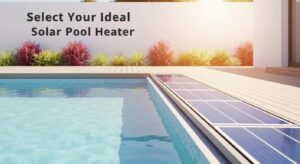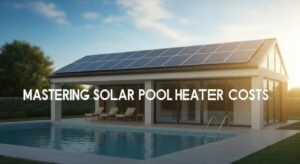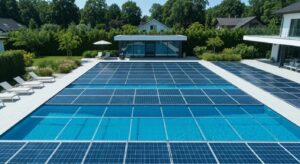Unlock Solar Pool Heater Care
Maintaining a solar pool heater with proven solar pool heater maintenance tips ensures consistent warmth, lower energy bills, and years of trouble-free operation. At Gomez Roofing: Florida Roofing & Solar Solutions, our certified technicians combine quality American-made components with rigorous inspection protocols to protect your investment from day one. In this guide, you’ll discover:
- Why regular maintenance is vital for longevity and efficiency
- A step-by-step cleaning checklist for DIY enthusiasts
- Common problems, targeted troubleshooting, and when to call in experts
- Seasonal winterization and summer care tailored to Florida’s climate
- The role of each system component and upgrade opportunities
With clear definitions, hands-on steps, and cost-saving insights, you’ll gain the confidence to keep your solar pool heater performing at its peak.
Why Is Solar Pool Heater Maintenance Essential for Longevity and Efficiency?
Solar pool heater maintenance is the practice of inspecting, cleaning, and servicing collector panels, plumbing loops, and controls to remove build-up, detect faults, and restore optimal heat transfer. By eliminating dirt and ensuring proper water flow, maintenance directly enhances heat capture and prevents premature wear on pumps and seals.
Routine maintenance delivers three core advantages: prolonged equipment life, maximized energy production, and reduced repair costs. Understanding these gains lays the groundwork for detailed cleaning procedures that follow.
Maintaining Solar Pool Heaters
Regular maintenance is essential for solar pool heaters to ensure they function efficiently and last for many years. This includes cleaning the solar collectors, checking for leaks, and monitoring water circulation to maximize heat transfer and prevent damage.
This source emphasizes the importance of regular cleaning and maintenance for optimal performance of solar pool heaters, which aligns with the article’s focus on efficient care and repair.
What Are the Key Benefits of Regular Solar Pool Heater Maintenance?
Proper maintenance unlocks measurable performance improvements and protects system components:
- Extended Lifespan – Eliminating scale and debris prevents corrosion and cracking of panel glazing.
- Peak Thermal Efficiency – Clear collectors absorb up to 15 percent more solar radiation for faster heating.
- Lower Operating Costs – Efficient heat transfer reduces pump runtime and energy consumption.
- Early Fault Detection – Regular inspections catch leaks and valve failures before they escalate.
Benefits of Solar Pool Heating
Solar pool heaters offer several benefits, including extended swimming seasons, reduced energy costs, and minimal maintenance requirements. These advantages make solar heating a cost-effective and environmentally friendly option for pool owners.
This source highlights the benefits of solar pool heating, which supports the article’s discussion of the advantages of using and maintaining these systems.
These benefits set the stage for a maintenance routine that keeps your heater working like new.
How Does Maintenance Improve Solar Pool Heater Efficiency and Lifespan?
Maintenance enhances efficiency by restoring the collector’s thermal conductivity and ensures longevity by addressing small issues before they cause catastrophic failures. Flush-cleaning debris from panels and inspecting seals every season prevents mineral build-up that reduces heat capture. Scheduled checks of pumps and valves eliminate cavitation damage and fluid hammer stress that shorten component life.
Tackling these tasks proactively creates a virtuous cycle of reliability and performance that extends system lifespan.
What Are the Cost Savings of Preventative Solar Pool Heater Care?
Investing in basic upkeep yields substantial savings compared to major repairs:
| Maintenance Action | Typical Cost Avoided | Long-Term Benefit |
|---|---|---|
| Annual professional inspection | $300–$500 in leak repairs | Prevents roof leaks and panel replacement |
| Biannual panel cleaning | $150–$250 in energy bills | Maintains 10–15 percent higher efficiency |
| Filter and valve servicing | $200–$400 pump replacements | Avoids costly pump failures |
| Seasonal winterization | $100 freeze damage repairs | Shields components from freeze stress |
By allocating a small portion of your pool budget to routine care, you protect against high-impact repairs and sustain peak efficiency year after year, which leads us to the exact cleaning steps you should follow.
How To Clean Solar Pool Panels: Step-by-Step Maintenance Checklist
Cleaning solar pool panels involves rinsing collector surfaces, removing scale build-up, and verifying flow controls to maintain peak heat absorption. Follow these steps every 3–6 months for clear glazing and unobstructed water channels.
What Tools and Supplies Are Needed for Solar Pool Panel Cleaning?
Before you begin panel cleaning, gather these essential tools and supplies:
| Tool or Supply | Purpose | Benefit |
|---|---|---|
| Soft-bristle brush | Gently removes loose debris from panel surfaces | Prevents scratching or seal damage |
| pH-neutral detergent | Dissolves oil-based grime without harming finish | Preserves panel coating integrity |
| Garden hose with low-pressure nozzle | Rinses panels evenly | Maintains uniform water flow |
| Telescoping extension pole | Provides safe roof access | Reduces risk of falls and back strain |
Equipped with these items, homeowners can achieve a safe, effective cleaning session that safeguards all collector components and prepares the system for optimal heating.
How Do You Safely Clean Solar Collectors Without Causing Damage?
To protect glazing and seals, always use non-abrasive solutions and low-pressure rinsing. Start from the panel bottom and work upward to avoid streaking, and never use high-pressure washers that can crack tempered glass or strip protective coatings. Finish by operating the pump briefly to flush any residual detergent through the plumbing loop, preventing internal corrosion.
Establishing safe cleaning practices ensures your solar collectors remain undamaged and ready to capture maximum solar energy.
How Often Should You Clean Solar Pool Panels for Optimal Performance?
Ideally, clear panels every 3 to 6 months, depending on local debris levels, roof pitch, and rainfall. In coastal or tree-lined areas, monthly visual checks and spot cleans prevent salt or pollen accumulation from impairing heat transfer. Consistent cleaning intervals guarantee uninterrupted performance and set a known schedule for professional inspections.
Determining the right frequency balances effort and outcome, leading into common mistakes to avoid.
What Are Common Mistakes to Avoid When Cleaning Solar Pool Panels?
Homeowners often inadvertently reduce performance by:
- Using abrasive brushes that wear down glazing and sealants.
- Skipping a post-clean flush of the collector loop, leaving detergent residue.
- Applying acidic cleaners that etch the glass and corrode metals.
- Neglecting to secure access points, risking falls and panel damage.
Avoiding these errors preserves panel condition and keeps your maintenance routine efficient and safe.
What Are the Most Common Solar Pool Heater Problems and How Can You Troubleshoot Them?
Common solar pool heater problems include leaks in the collector circuit, low water flow, panel fouling from dirt and debris, and sensor or controller malfunctions. Each fault demands a tailored troubleshooting approach to restore peak heat delivery.
Common Issues with Solar Pool Heaters
Common problems with solar pool heaters include leaks, low water flow, and accumulation of dirt and debris on the collectors. Addressing these issues promptly is crucial for maintaining the system’s efficiency and preventing further damage.
This source identifies common problems such as leaks and low flow rates, which are also discussed in the article’s troubleshooting section.
How to Identify and Fix Solar Pool Heater Leaks?
Identifying collector leaks starts with a visual scan for wet seams and drip trails along panel plumbing. A simple pressure test using a meter reveals hairline cracks in hoses or fittings. Repair by replacing damaged sealants or swapping out compromised hoses, then re-pressurize to confirm a watertight loop.
Swift leak repairs restore hydraulic integrity and prevent heat loss that undermines system efficiency.
What Causes Low Water Flow in Solar Pool Heating Systems and How to Resolve It?
Reduced flow often stems from clogged filters, air locks, or worn pump impellers. The following table matches causes with resolutions:
| Symptom | Cause | Resolution |
|---|---|---|
| Weak output from panels | Filter basket blockage | Clean or replace filter elements |
| No flow through collectors | Air trapped in plumbing loop | Bleed air via purge valves until water flows |
| Uneven heat distribution | Worn pump impeller or motor inefficiency | Service or replace pump internals |
Addressing these flow issues promptly prevents overheating and uneven heating cycles that stress system parts.
How Does Dirt and Debris Affect Solar Panels and What Cleaning Methods Work Best?
Dirt, pollen, and algae form an insulating layer that reduces solar absorption by up to 20 percent. Regular brushing followed by a pH-neutral detergent rinse restores full glazing transparency. For stubborn mineral scale, a diluted vinegar solution applied sparingly and rinsed immediately dissolves deposits without harming seals.
Effective cleaning methods remove barriers to sunlight and maximize thermal performance under all conditions.
How to Detect and Address Malfunctioning Sensors and Controllers?
Malfunctioning sensors or controllers can cause erratic pump cycling or no heat transfer at all. Test thermostat sensors with a multimeter for voltage consistency under temperature changes. If readings deviate from specifications, replace the sensor module and recalibrate the controller to resume accurate heat-demand signaling.
Restoring sensor integrity ensures precise operation and prevents unnecessary pump wear.
When Should You Call a Professional for Solar Pool Heater Repair or Maintenance?
Professional solar pool heater service is recommended when system faults exceed basic DIY capabilities—particularly electrical issues, major leaks, and persistent inefficiencies that impact energy savings.
What Are the Signs That Require Professional Solar Pool Heater Inspection?
Invite an expert when you encounter:
- Persistent leaks after DIY seal repairs
- Electrical or sensor failures indicated by error codes
- Significant heat loss despite clean panels and proper flow
- Unusual pump noises or frequent cycling
Recognizing these signs early secures warranty coverage and avoids emergency replacements.
How Do Professional Repairs Improve Solar Pool Heater Performance?
Certified technicians employ pressure testing, thermal imaging, and component calibration to diagnose hidden faults and restore factory efficiencies. They use OEM-grade sealants and replacement parts to reinforce system integrity and recalibrate controls for precise heat delivery, extending both performance and lifespan.
Professional intervention transforms reactive fixes into long-term reliability.
What Is the Typical Solar Pool Heater Repair Cost and What Factors Affect It?
Repair expenses vary by issue severity and component type:
- Leak repair: $300–$600, depending on panel access and seal type
- Pump or valve replacement: $400–$800 for American-made assemblies
- Sensor/controller servicing: $200–$400 for diagnostics and recalibration
- Panel glazing replacement: $800–$1,200 for individual collector modules
Labor rates, part availability, and system complexity influence final cost—but preventative maintenance keeps these figures at the lower end of the range.
How Does Gomez Roofing Provide Expert Solar Pool Heater Maintenance in Florida?
Gomez Roofing combines local climate expertise with industry-leading practices to deliver:
- Full-system diagnostics using pressure tests and thermal scans
- Quality component sourcing from American manufacturers
- Tailored maintenance plans aligned with hurricane and freeze-risk schedules
- Comprehensive service reports that document performance gains
Our holistic approach ensures your solar pool heater thrives in Florida’s unique weather patterns.
How to Prepare Your Solar Pool Heater for Seasonal Changes: Winterization and Summer Maintenance Tips
Seasonal care protects panels and plumbing from temperature extremes and storm stress. A well-executed seasonal routine extends component life and maintains efficient heating year-round.
When and How Should You Winterize Your Solar Pool Heater in Florida?
Although deep freezes are rare in Florida, overnight lows can stress plumbing seals. To winterize:
- Shut off pump and drain collectors via purge valves
- Bypass panels with a diverter valve to prevent fluid stagnation
- Remove and store sensors indoors if freeze warnings appear
Winterization of Solar Pool Heaters
In regions with freezing temperatures, winterizing a solar pool heater involves draining the collectors and piping to prevent damage. This process protects the system from potential freeze-related issues and ensures its longevity.
This source provides information on winterization, which is a key aspect of seasonal maintenance discussed in the article.
These actions safeguard against occasional cold snaps without full system shutdown.
What Summer Maintenance Steps Keep Your Solar Pool Heater Efficient?
Florida’s intense sun and storms require:
- Monthly inspections for debris accumulation and UV damage
- Tightening roof mounts and checking flashing after high-wind events
- Flushing panels after heavy pollen or salt spray periods
Consistent summer upkeep ensures uninterrupted solar gain and reliable pool warming.
How Do Climate Factors Like Hurricanes Affect Solar Pool Heater Maintenance?
High winds and flying debris can loosen panel mounts or damage glazing. After any tropical event, schedule:
- Mount integrity check for flashing and fasteners
- Panel surface inspection for cracks or seal breaches
- System flush to clear rain-borne contaminants
Proactive post-storm inspections restore safety and performance faster than emergency repairs. For reinforced rooftop infrastructure that supports solar equipment, consider solutions like Commercial Decking – Gomez Roofing to enhance resilience under extreme conditions.
What Are the Main Components of a Solar Pool Heating System and How Do They Impact Maintenance?
A solar pool heating system comprises collectors, a pump and filter, flow control valves, and a control unit. Each part influences maintenance frequency and method.
| System Component | Primary Function | Maintenance Impact |
|---|---|---|
| Solar Collectors/Panels | Absorb sunlight and transfer heat to water | Require regular cleaning to prevent fouling |
| Pump & Filter Assembly | Circulate pool water through the collectors | Needs filter cleaning and pump servicing |
| Flow Control Valves | Direct water flow to heating or bypass | Demand periodic lubrication and leak checks |
| Sensors & Controllers | Monitor temperature and regulate pump | Require calibration and occasional replacement |
Understanding these roles guides targeted care and avoids unnecessary downtime.
What Role Do Solar Collectors/Panels Play in Pool Heating?
Solar collectors capture and convert sunlight into thermal energy, circulating heated water back to the pool. Their performance hinges on clear glazing and intact seals, making surface cleaning and visual inspections essential for uninterrupted heat capture.
How Does the Pool Pump and Filter Affect Solar Pool Heater Efficiency?
The pump provides the hydraulic pressure needed to move water through the collectors, while the filter eliminates particulates that clog panels. A worn impeller or a blocked filter drastically reduces flow, so regular servicing of these components ensures consistent thermal exchange.
What Are Flow Control Valves and How Do They Influence Maintenance?
Flow control valves route water to either the solar circuit or bypass loops, regulating temperature and preventing overheating. Valve handles and seals require lubrication checks and leak inspections to maintain precise flow control over thousands of cycles.
How Can You Maximize Your Solar Pool Heater Investment with Upgrades and Professional Services?
Upgrading panels, controls, or adding monitoring features can boost return on investment by enhancing efficiency and extending system life well beyond standard expectations.
What Are the Benefits of Upgrading Your Existing Solar Pool Heating System?
Upgrades deliver immediate gains:
- High-efficiency collectors improve heat output by 10 percent or more
- Smart controllers optimize pump run-times based on weather forecasts
- Automated valves reduce manual intervention and human error
These enhancements translate into faster heat-up times and lower operating expenses.
How Does Regular Professional Maintenance Extend System Lifespan and Efficiency?
Professional service includes detailed diagnostics, component calibration, and leak-proof sealing that surpasses DIY routines. Technicians adjust flow rates, test thermostat accuracy, and replace worn parts before they fail—safeguarding your heater’s performance year after year.
What Should Homeowners Know About Solar Pool Heater Warranty and Service Plans?
Most manufacturers offer 10- to 20-year warranties on collectors and limited warranties on pumps and controls. Service plans from certified installers provide annual inspections, priority repairs, and discounted parts, ensuring warranty conditions remain valid and system efficiency stays high.
Proactive planning and strategic upgrades combine to safeguard your solar pool heater investment for decades of reliable warmth.
Maintaining your solar pool heater with these expert-recommended tips keeps your pool season longer, energy bills lower, and equipment protected against Florida’s unique weather challenges. By following systematic cleaning, troubleshooting faults early, and scheduling professional inspections, you ensure peak performance and maximum return on your solar investment. Explore our full range of roofing and solar services today for tailored maintenance plans and upgrades designed to extend the life of your pool heating system.




